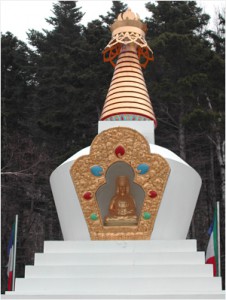Stupa of Enlightenment

Aspiration
Work started in the summer of 1999 on a stupa at Gampo Abbey that contains relics of the Vidyadhara Chögyam Trungpa Rinpoche. It is the first stupa built in Nova Scotia. Kyabje Thrangu Rinpoche, Abbot of Gampo Abbey, requested in 1996 that the stupa be built. The project had the strong support of Sakyong Mipham Rinpoche and fulfilled Chögyam Trungpa Rinpoche’s request that his relics be distributed between RMSC (now Drala Mountain Center, Colorado) Karme Chöling (Vermont) and Gampo Abbey. Kyabje Thrangu Rinpoche consecrated the completed stupa in 2001.
A stupa traditionally represents the mind of the Buddha and has the power to convey the mind transmission to those who gaze at it.
Kyabje Thrangu Rinpoche
This stupa, he said, is dedicated to world peace, and will become a tourist attraction that will bring many people to the spiritual path. To symbolize the overcoming of aggression, Rinpoche buried weapons in the ground below where the stupa was built, including a World War I rifle donated by a Cape Breton neighbour of the Abbey, before consecrating the site.
Thrangu Rinpoche also asked that the lojong slogans, teaching the Bodhisattva practices of generosity, patience, discipline, exertion, meditation, and wisdom, be inscribed around the stupa on terraced walls so that they can be read while circumambulating.
The stupa project opened an important dialogue between the Abbey and the surrounding Pleasant Bay community. The local community has benefited from the increased tourism that the stupa has brought to the region.
The Process
Kyabje Thrangu Rinpoche appointed Lama Tashi Tondrup, one of his senior lamas, to supervise the elaborate ritual details for the construction of the mandalas inside the stupa, including the lifeforce pole at its centre. Accompanying him were two other lamas to assist in the procedures, one from Nepal and one from China. Gampo Abbey staff collected the prescribed substances and materials, including precious stones, fruits, and flowers that traditionally pack the lion throne. Construction of the 24 foot high structure was supervised by sangha architect David Garrett and sangha builder Don Beamish, both of whom also collaborated to construct the Abbey’s three-year retreat centre.
The stupa symbolizes the fact that the Buddhist community and teachings have genuinely taken root in Nova Scotia.
Kyabje Thrangu Rinpoche has stated that Gampo Abbey fulfills a critical role in creating enlightened society in Nova Scotia, by preserving the Buddhist teachings in their pure and unadulterated form.

The Stupa of Enlightenment requires regular ongoing maintenance and is supported solely by generous donations. If you would like to support the Stupa visit our donations page




